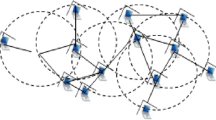Abstract
The importance of accurate mobility models for mobile ad hoc network (MANET) evaluation is widely recognized in literature. Existing MANET mobility models can be generally classified into two categories: entity and group mobility models. The latter is of particular interest as group motion occurs commonly in scenarios where MANETs are deployed, such as firefighting and battlefield operations. This paper provides a systematic and critical review of recent group mobility models proposed for MANETs. It also discusses the potential of using or adapting these mobility models for other emerging network types.




Similar content being viewed by others
References
Royer, E. M., & Toh, C. K. (1999). A review of current routing protocols for ad hoc mobile wireless networks. Personal Communications, IEEE, 6, 46–55.
Camp, T., Boleng, J., & Davies, V. (2002). A survey of mobility models for ad hoc network research. Wireless Communications and Mobile Computing, 2, 483–502.
Hong, X. et al. (1999) A group mobility model for ad hoc wireless networks. In Proceedings of the 2nd ACM international workshop on modeling, analysis and simulation of wireless and mobile systems (pp. 53–60).
Musolesi, M., & Mascolo, C. (2006). A community based mobility model for ad hoc network research. In Proceedings of the 2nd ACM/SIGMOBILE international workshop on multi-hop ad hoc networks: From theory to reality (pp. 31–38) Florence, Italy.
Wang, K. H., & Li, B. (2002). Group mobility and partition prediction in wireless ad-hoc networks. In IEEE international conference on communications, New York.
Williams, S. A., & Huang, D. (2009). Group force mobility model and its obstacle avoidance capability. Acta Astronautica, 65, 949–957.
Wu, K., & Yu, Q. (2006) A multi-group coordination mobility model for ad hoc networks. In Proceedings military communications conference, Washington, DC.
Ng, J. M., & Zhang, Y. (2005). A mobility model with group partitioning for wireless ad hoc networks. In Proceedings of the third international conference on information technology and applications (Vol. 2).
Zhou, B., Xu, K., & Gerla, M. (2004). Group and swarm mobility models for ad hoc network scenarios using virtual tracks. In Proceedings of military communications conference, Monterey, CA.
Vastardis, N., & Yang, K. (2014). An enhanced community-based mobility model for distributed mobile social networks. Journal of Ambient Intelligence and Humanized Computing, 5, 65–75.
Bai, F., Sadagopan, N., & Helmy, A. (2003) IMPORTANT: A framework to systematically analyze the impact of mobility on performance of routing protocols for ad hoc networks. In Proceedings of INFOCOM 2003, San Francisco, CA.
Qunwei, Z., Xiaoyan, H., & Sibabrata, R. (2004) Recent advances in mobility modeling for mobile ad hoc network research. In Proceedings of the 42nd annual southeast regional conference, Huntsville, AL.
Aschenbruck, N., Gerhards-Padilla, E., & Martini, P. (2008). A survey on mobility models for performance analysis in tactical mobile networks. Journal of Telecommunications and Information Technology, 2, 54–61.
Haerri, J., Filali, F., & Bonnet, C. (2009). Mobility models for vehicular ad hoc networks: A survey and taxonomy. IEEE Communications Surveys and Tutorials, 11(4), 19–41.
Dang, H., & Wu, H. (2010). Clustering and cluster-based routing protocol for delay-tolerant mobile networks. IEEE Transactions on Wireless Communications, 9(6), 1874–1881.
Author information
Authors and Affiliations
Corresponding author
Rights and permissions
About this article
Cite this article
Aung, C.Y., Seet, B.C., Zhang, M. et al. A Review of Group Mobility Models for Mobile Ad Hoc Networks. Wireless Pers Commun 85, 1317–1331 (2015). https://doi.org/10.1007/s11277-015-2842-z
Published:
Issue Date:
DOI: https://doi.org/10.1007/s11277-015-2842-z




